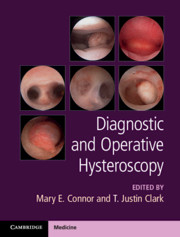Book contents
- Diagnostic and Operative Hysteroscopy
- Diagnostic and Operative Hysteroscopy
- Copyright page
- Dedication
- Contents
- Videos
- Contributors
- Chapter 1 An Introduction to Hysteroscopy
- Chapter 2 Anatomy and Physiology of the Uterus
- Chapter 3 Infrastructure and Instrumentation for Hysteroscopy
- Chapter 4 Diagnostic Hysteroscopy: Accuracy and Interpretation of Findings
- Chapter 5 Hysteroscopy Techniques and Treatment Settings
- Chapter 6 Analgesia and Anaesthesia for Hysteroscopy
- Chapter 7 Indications for Hysteroscopy
- Chapter 8 Hysteroscopic Electrosurgery
- Chapter 9 Complications of Hysteroscopic Surgery
- Chapter 10 Hysteroscopic Endometrial Polypectomy
- Chapter 11 Endometrial Ablation
- Chapter 12 Hysteroscopic Management of Fibroids
- Chapter 13 Hysteroscopic Sterilisation
- Chapter 14 Management of Congenital Uterine and Vaginal Anomalies
- Chapter 15 Hysteroscopic Management of Uterine Adhesions
- Chapter 16 Unusual Hysteroscopic Situations: Caesarean Niche and Retained Placental Tissue
- Chapter 17 Audit, Data Collection and Clinical Governance in Hysteroscopy
- Chapter 18 Training in Hysteroscopic Skills
- Chapter 19 Research and New Developments in Hysteroscopy
- Index
- References
Chapter 8 - Hysteroscopic Electrosurgery
Published online by Cambridge University Press: 10 September 2020
- Diagnostic and Operative Hysteroscopy
- Diagnostic and Operative Hysteroscopy
- Copyright page
- Dedication
- Contents
- Videos
- Contributors
- Chapter 1 An Introduction to Hysteroscopy
- Chapter 2 Anatomy and Physiology of the Uterus
- Chapter 3 Infrastructure and Instrumentation for Hysteroscopy
- Chapter 4 Diagnostic Hysteroscopy: Accuracy and Interpretation of Findings
- Chapter 5 Hysteroscopy Techniques and Treatment Settings
- Chapter 6 Analgesia and Anaesthesia for Hysteroscopy
- Chapter 7 Indications for Hysteroscopy
- Chapter 8 Hysteroscopic Electrosurgery
- Chapter 9 Complications of Hysteroscopic Surgery
- Chapter 10 Hysteroscopic Endometrial Polypectomy
- Chapter 11 Endometrial Ablation
- Chapter 12 Hysteroscopic Management of Fibroids
- Chapter 13 Hysteroscopic Sterilisation
- Chapter 14 Management of Congenital Uterine and Vaginal Anomalies
- Chapter 15 Hysteroscopic Management of Uterine Adhesions
- Chapter 16 Unusual Hysteroscopic Situations: Caesarean Niche and Retained Placental Tissue
- Chapter 17 Audit, Data Collection and Clinical Governance in Hysteroscopy
- Chapter 18 Training in Hysteroscopic Skills
- Chapter 19 Research and New Developments in Hysteroscopy
- Index
- References
Summary
Surgical procedures using electrosurgery can be undertaken within the uterine cavity to address excessive menstrual blood loss and to enhance fertility. The insertion of specialised electrodes down hysteroscopic instruments enables the direct application of electricity to uterine tissue. The electrical energy is transformed into heat and, depending upon how this heat is focused, can be used to cut tissue and excise lesions, or cauterise and ablate tissue (Box 8.1). The larger hysteroscopic resectoscopes with outer diameters of 7 to 8.5 mm are generally, though not exclusively, used during inpatient procedures with a general anaesthetic or regional anaesthesia. The introduction of smaller electrodes (1.67 mm, or 5 Fr) has enabled therapeutic procedures to be undertaken using diagnostic hysteroscopes with an operating channel. This has supported the development of outpatient operative hysteroscopy for the removal of small intrauterine lesions.
- Type
- Chapter
- Information
- Diagnostic and Operative Hysteroscopy , pp. 96 - 108Publisher: Cambridge University PressPrint publication year: 2020



